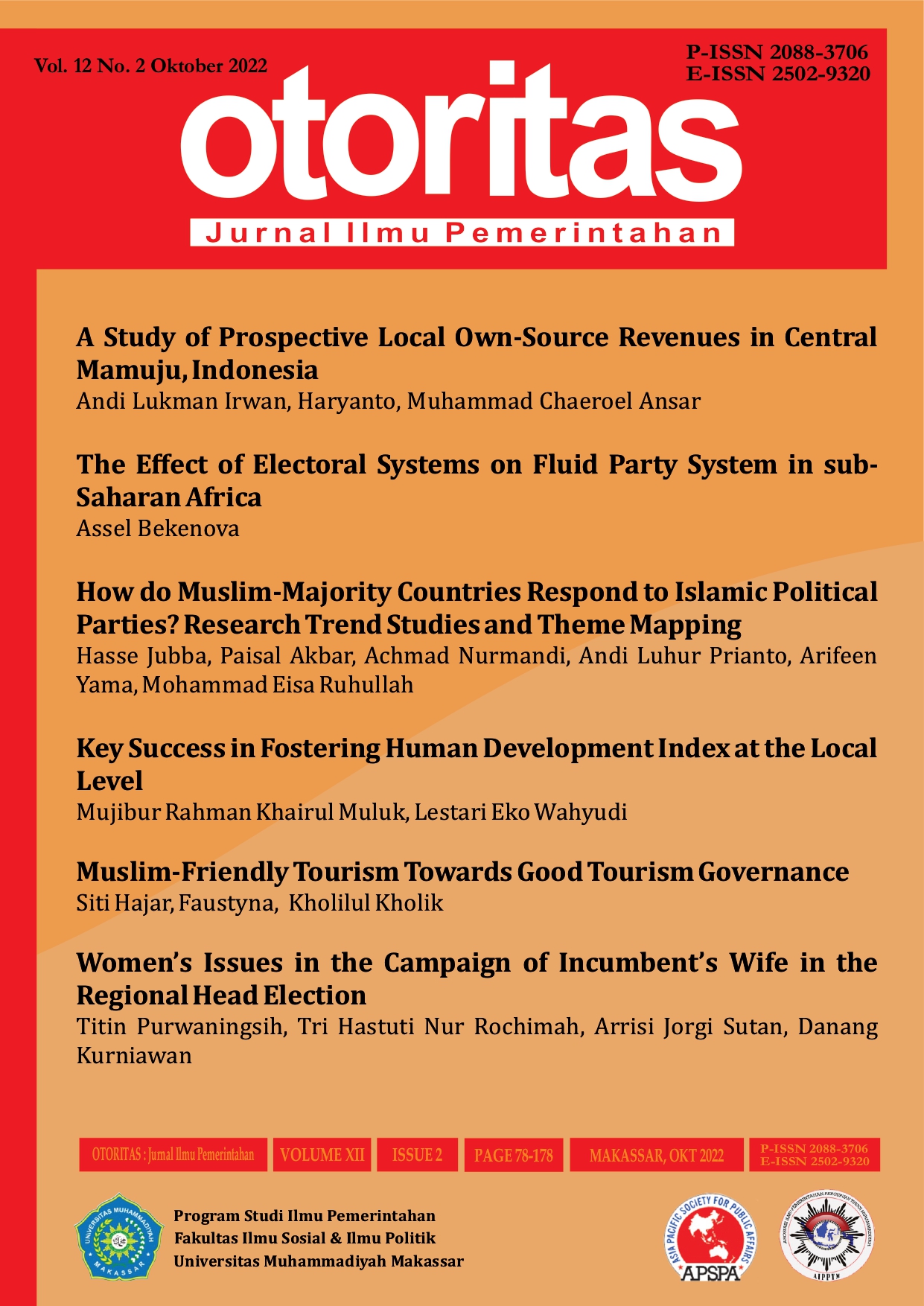The Effect of Electoral Systems on Fluid Party System in sub-Saharan Africa
DOI:
https://doi.org/10.26618/ojip.v12i2.7723Keywords:
Index of Fluidity, Electoral Systems, Sartori's Typology of Party Systems, Duverger's LawAbstract
The article, based on a literature review, examines the impact of electoral systems on the fluidity party system in sub-Saharan Africa. Most authors identify institutional and social factors influencing the change in party systems. At the same time, they use the indices Laakso and Taagepera and Rae to operationalize variable parties. However, there is a lack of research in the literature on electoral systems regarding its impact on stability or change of interparty competition patterns. This is due to, firstly, the relative novelty of the recently developed index of fluidity, and secondly, the desire of scholars to use already widely tested, established measures of measurement. We believe that, in contrast to previous studies, where the unit of analysis is the party and not the party system. The Index of Fluidity will allow us to predict how majoritarian or proportional systems and WGI scores will affect the structure or fluidity of party systems in 49 sub-Saharan African countries. The results of study indicate that the changes taking place in electoral systems have significantly affected the fluidity of party systems. The results of the study indicate that measures of WGI and ethnicity negatively affected fluidity of party systems in 49 sub-Saharan African countries. This suggests that the more unstable the party system, the more ineffective the government becomes. Whereas the results of the main hypothesis indicate a statistically significant effect of changing electoral systems on the fluidity of party systems. In other words, the more often political reforms are carried out in the electoral sphere, the higher the indicators of instability of party system, which, according to the typology of party system of Sartori, will change either radically from one-party to polarized pluralism or atomised party system or slightly from one-party to hegemonistic or predominant.
References
Aydogan, A. (2021). Party systems and ideological cleavages in the Middle East and North Africa. Party Politics, 27(4), 814–826. https://doi.org/10.1177/1354068819894299
Bakke, E., & Sitter, N. (2005). Patterns of Stability: Party Competition and Strategy in Central Europe since 1989. Party Politics, 11(2), 243–263. https://doi.org/10.1177/1354068805049779
Bértoa, F. C., & Enyedi, Z. (2021). Party system closure: Party alliances, government alternatives, and democracy in Europe. Oxford, UK: Oxford University Press.
Blais, A., & Massicotte, L. (1996). Mixed electoral systems: An overview. Representation, 33(4), 115–118. https://doi.org/10.1080/00344899608522970
Blondel, J. (1968). Party Systems and Patterns of Government in Western Democracies. Canadian Journal of Political Science, 1(2), 180–203. https://doi.org/10.1017/S0008423900036507
Bochsler, D. (2009). Are Mixed Electoral Systems the Best Choice for Central and Eastern Europe or the Reason for Defective Party Systems? Politics & Policy, 37(4), 735–767. https://doi.org/10.1111/j.1747-1346.2009.00196.x
Bogaards, M. (2004). Counting parties and identifying dominant party systems in Africa. European Journal of Political Research, 43(2), 173–197. https://doi.org/10.1111/j.1475-6765.2004.00150.x
Bogaards, M. (2008). Dominant Party Systems and Electoral Volatility in Africa. Party Politics, 14(1), 113–130. https://doi.org/10.1177/1354068807083825
Botha, S. (1996). South Africa’s Party System. Journal of Theoretical Politics, 8(2), 209–225. https://doi.org/10.1177/0951692896008002006
Dalton, R. J. (2008). The Quantity and the Quality of Party Systems. Comparative Political Studies, 41(7), 899–920. https://doi.org/10.1177/0010414008315860
Duverger, M. (1951). Les Partis Politiques. Paris: Librairie Armand Colin.
Erdmann, G., & Basedau, M. (2008). Party systems in Africa: Problems of categorising and explaining party systems. Journal of Contemporary African Studies, 26(3), 241–258. https://doi.org/10.1080/02589000802332408
Gaines, B. J., & Taagepera, R. (2013). How to Operationalize Two-Partyness. Journal of Elections, Public Opinion & Parties, 23(4), 387–404. https://doi.org/10.1080/17457289.2013.770398
Giannetti, D., & Laver, M. (2001). Party system dynamics and the making and breaking of Italian governments. Electoral Studies, 20(4), 529–553. https://doi.org/10.1016/S0261-3794(00)00048-2
Hartmann, C. (2022). Authoritarian origins of term limit trajectories in Africa. Democratization, 29(1), 57–73. https://doi.org/10.1080/13510347.2021.1992387
Hoffman, A. L. (2005). Political parties, electoral systems and democracy: A cross-national analysis. European Journal of Political Research, 44(2), 231–242. https://doi.org/10.1111/j.1475-6765.2005.00225.x
Idea, I. (2012). Data on electoral system. Stockholm.
Kinyondo, A., & Pelizzo, R. (2022). Evaluating the Performance of Parliamentary Committees. Otoritas: Jurnal Ilmu Pemerintahan, 12(1), 1–15.
Kostadinova, T. (2002). Do mixed electoral systems matter?: a cross-national analysis of their effects in Eastern Europe. Electoral Studies, 21(1), 23–34. https://doi.org/10.1016/S0261-3794(00)00032-9
Kuenzi, M., & Lambright, G. (2001). Party System Institutionalization in 30 African Countries. Party Politics, 7(4), 437–468. https://doi.org/10.1177/1354068801007004003
Laakso, M., & Taagepera, R. (1979). “Effective” Number of Parties. Comparative Political Studies, 12(1), 3–27. https://doi.org/10.1177/001041407901200101
Lijphart, A. (1990). The Political Consequences of Electoral Laws, 1945–85. American Political Science Review, 84(2), 481–496. https://doi.org/10.2307/1963530
Lijphart, A. (2017). Patterns of Democracy. Yale University Press. https://doi.org/10.12987/9780300189124
Lipset, S. M., & Rokkan, S. (1967). Cleavage structures, party systems, and voter alignments: an introduction. New York: Free Press New York.
Mainwaring, S. (1993). Presidentialism, Multipartism, and Democracy. Comparative Political Studies, 26(2), 198–228. https://doi.org/10.1177/0010414093026002003
Mozaffar, S., & Scarritt, J. R. (2005). The Puzzle of African Party Systems. Party Politics, 11(4), 399–421. https://doi.org/10.1177/1354068805053210
Mukhtarova, A. (2020). Effects of Party System Fluidity on Legislative Oversight and Good Governance Indicators--in the context of Sub-Saharan African Countries. Current Research Journal of Social Sciences and Humanities, 3(2), 232–243. https://doi.org/10.12944/CRJSSH.3.2.10
Neto, O. A., & Cox, G. W. (1997). Electoral Institutions, Cleavage Structures, and the Number of Parties. American Journal of Political Science, 41(1), 149. https://doi.org/10.2307/2111712
Norris, P. (1997). Choosing Electoral Systems: Proportional, Majoritarian and Mixed Systems. International Political Science Review, 18(3), 297–312. https://doi.org/10.1177/019251297018003005
Nwokora, Z., & Pelizzo, R. (2015). The Political Consequences of Party System Change. Politics & Policy, 43(4), 453–473. https://doi.org/10.1111/polp.12124
Nwokora, Z., & Pelizzo, R. (2018). Measuring Party System Change: A Systems Perspective. Political Studies, 66(1), 100–118. https://doi.org/10.1177/0032321717710568
Ordeshook, P. C., & Shvetsova, O. V. (1994). Ethnic Heterogeneity, District Magnitude, and the Number of Parties. American Journal of Political Science, 38(1), 100. https://doi.org/10.2307/2111337
Pasquino, G. (2005). the political science of giovanni sartori. European Political Science, 4(1), 33–41. https://doi.org/10.1057/palgrave.eps.2210003
Pedersen, M. N. (1979). The Dynamics of European Party Systems: Changing Patterns of Electoral Volatility. European Journal of Political Research, 7(1), 1–26. https://doi.org/10.1111/j.1475-6765.1979.tb01267.x
Pelizzo, R., & Nwokora, Z. (2016). Bridging the Divide: Measuring Party System Change and Classifying Party Systems. Politics & Policy, 44(6), 1017–1052. https://doi.org/10.1111/polp.12188
Pelizzo, R., & Nwokora, Z. (2018). Party System Change and the Quality of Democracy in East Africa. Politics & Policy, 46(3), 505–528. https://doi.org/10.1111/polp.12255
Pelizzo, R., & Stapenhurst, F. (2013). Parliamentary Oversight Tools. London: Routledge. https://doi.org/10.4324/9780203151228
Powell, G. B. (1982). Contemporary Democracies. Cambridge: Harvard University Press. https://doi.org/10.4159/9780674042353
Rae, D. W. (1967). The political consequences of electoral laws. New Haven: Yale university press.
Sartori, G. (1976). Parties and Party systems: a framework for analysis. Colchester: ECPR Press.
Sartori, G. (2005). Party Types, Organisation and Functions. West European Politics, 28(1), 5–32. https://doi.org/10.1080/0140238042000334268
Sartori, G. (2016). Elementi di teoria politica. Bologna: Il Mulino.
Shugart, M. S., & Taagepera, R. (2018). Electoral system effects on party systems. In The Oxford handbook of electoral systems. Oxford, UK: Oxford University Press.
Stockton, H. (2001). Political Parties, Party Systems, and Democracy in East Asia. Comparative Political Studies, 34(1), 94–119. https://doi.org/10.1177/0010414001034001004
Taagepera, R. (1999). Supplementing the effective number of parties. Electoral Studies, 18(4), 497–504. https://doi.org/10.1016/S0261-3794(99)00020-7
Taagepera, R., & Grofman, B. (2006). Rethinking Duverger’s Law: Predicting the Effective Number of Parties in Plurality and PR Systems - Parties Minus Issues Equals One*. European Journal of Political Research, 13(4), 341–352. https://doi.org/10.1111/j.1475-6765.1985.tb00130.x
Taagepera, R., & Shugart, M. S. (1993). Predicting the Number of Parties: A Quantitative Model of Duverger’s Mechanical Effect. American Political Science Review, 87(2), 455–464. https://doi.org/10.2307/2939053
Taylor, M., & Herman, V. M. (1971). Party Systems and Government Stability. American Political Science Review, 65(1), 28–37. https://doi.org/10.2307/1955041
Tsebelis, G. (1999). Veto Players and Law Production in Parliamentary Democracies: An Empirical Analysis. American Political Science Review, 93(3), 591–608. https://doi.org/10.2307/2585576
Ware, A. (2009). The dynamics of two-party politics: party structures and the management of competition. Oxford, UK: OUP Oxford.
Downloads
Published
Issue
Section
License
The Editorial Team of Otoritas: Jurnal Ilmu Pemerintahan reserves the right to transfer the copyright of the article once it has been accepted and a decision has been made to publish it.
Department of Government Studies, Faculty of Social and Political Sciences, Universitas Muhammadiyah Makassar in collaboration with Muhammadiyah’s College Association of Government Studies (AIPPTM) and Asia Pacific Society for Public Affairs (APSPA) as the publisher of Otoritas: Jurnal Ilmu Pemerintahan holds the copyright of all articles published in this journal.
The Publisher holds the right to reproduce and distribute the article and author is not allowed to publish the same article published in this journal.
Statement of Authenticity and Manuscript Copyright can be downloaded: here
After filling in the statement letter, please send via e-mail: otoritas@unismuh.ac.id






